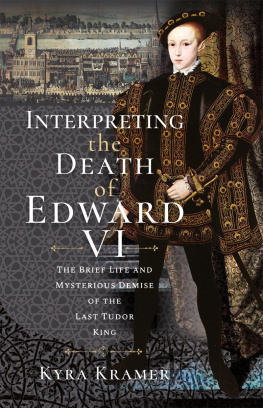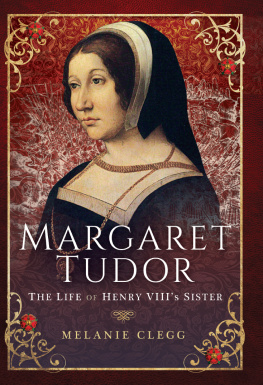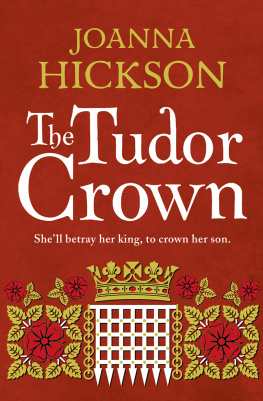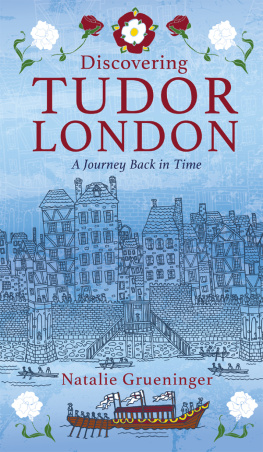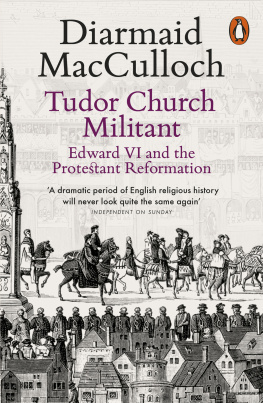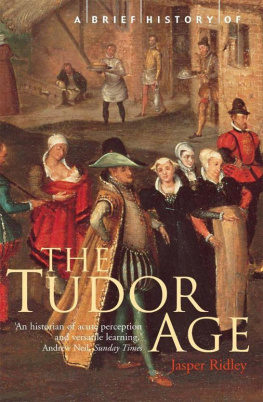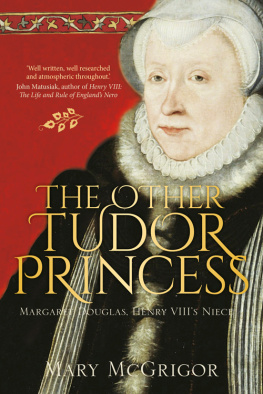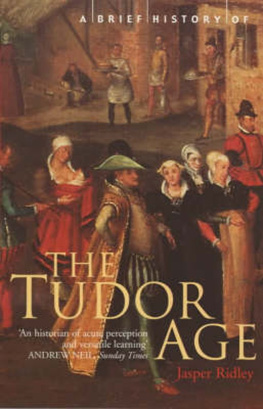Pagebreaks of the print version

Interpreting the Death of Edward VI
Interpreting the Death of Edward VI
The Life and Mysterious Demise of the Last Tudor King
Kyra Krammer
First published in Great Britain in 2022 by
Pen & Sword History
An imprint of
Pen & Sword Books Ltd
Yorkshire Philadelphia
Copyright Kyra Krammer 2022
ISBN 978 1 39909 208 1
ePUB ISBN 978 1 39909 209 8
Mobi ISBN 978 1 39909 209 8
The right of Kyra Krammer to be identified as Author of this work has been asserted by her in accordance with the Copyright, Designs and Patents Act 1988.
A CIP catalogue record for this book is available from the British Library.
All rights reserved. No part of this book may be reproduced or transmitted in any form or by any means, electronic or mechanical including photocopying, recording or by any information storage and retrieval system, without permission from the Publisher in writing.
Pen & Sword Books Limited incorporates the imprints of Atlas, Archaeology, Aviation, Discovery, Family History, Fiction, History, Maritime, Military, Military Classics, Politics, Select, Transport, True Crime, Air World, Frontline Publishing, Leo Cooper, Remember When, Seaforth Publishing, The Praetorian Press, Wharncliffe Local History, Wharncliffe Transport, Wharncliffe True Crime and White Owl.
For a complete list of Pen & Sword titles please contact
PEN & SWORD BOOKS LIMITED
47 Church Street, Barnsley, South Yorkshire, S70 2AS, England
E-mail:
Website: www.pen-and-sword.co.uk
Or
PEN AND SWORD BOOKS
1950 Lawrence Rd, Havertown, PA 19083, USA
E-mail:
Website: www.penandswordbooks.com
This book is dedicated to my beloved aunt, Alana Begley Parks, with admiration for her deep faith and quiet courage.
Foreword
The Mysterious Deaths of the Tudor Heirs
K ing Edward VI is often overlooked because his short reign fell between the much more dynamic tenures of his father, King Henry VIII, and the regimes of his elder half-sisters, Queen Mary I and Queen Elizabeth I. Additionally, since Edward was merely nine years old when he gained the throne and only fifteen when he died, there is also an assumption that he would have had very little influence over his own rule. In reality, the precocious boy was taking charge of his own statecraft by the tender age of thirteen, and his brief command of his kingdom had a profound effect on England and Wales. In the little time he was allotted by fate to use his powers as monarch he showed himself to be as fiscally canny as his grandfather, Henry VII, and as politically far-sighted as his sibling, Queen Elizabeth I, whose impressive rule now completely overshadows his own. Sadly, his rule also revealed Edward to be as dogmatic and religiously intractable as his other half-sister, who is saddled by the unfortunate nickname of Bloody Mary. If he had lived, the last Tudor king would have had as much impact both good and bad on the course of English history as men who began his famous dynasty and the women who ended it after him.
But he did not live. Moreover, his death was relatively sudden and unexpected. The narrative in popular history books often assumes that because he passed away so young that he had always been unhealthy. This is inaccurate. Edward had been blessed with a robust constitution in childhood, surviving many of the ailments that underlay the horrific child mortality rates in early modern Europe. It was only a few months before his untimely demise that the kings health began to fail. His ultimate cause of death is still being debated by historians, but what is seldom discussed is the fact his fate was shared by two other teenagers in his famous family his uncle Arthur Tudor and his half-brother Henry Fitzroy.
By the time Edward was born, the preceding generations of the Tudor dynasty had lost all but one of its male heirs. King Henry VIII would be the only Tudor prince to ever survive to adulthood. His older brother, Arthur, had died at age fifteen. His sons by his first queen, Katherina of Aragon, had all died shortly after their birth or were stillborn. His illegitimate son, Henry Fitzroy, had died in his mid-teens. His second queen, Anne Boleyn, had miscarried of her savior when she lost a supposedly male fetus in 1536. Jane Seymours son was Henrys last hope for his lineage, but in spite of all the precautions taken by the royal physicians, King Edward also died before his sixteenth birthday. While the Tudor genes live on in the current monarch of Great Britain, they have been passed down through the children of Henry VIIIs sister, Margaret, rather than the king himself.
Why did the Tudor kings have such a hard time keeping their sons alive? All children of that time were acutely vulnerable, with more than 40% of children dying before their tenth birthday. As is still the case, boys were more vulnerable than girls, succumbing to accidents and illnesses more often than their female counterparts. Nevertheless, the Tudor lack of surviving princes stands out as a statistical oddity. Henry VIII had at least five acknowledged sons; surely one of them should have lived long enough to marry and reproduce?
The fetal losses of Henrys wives can potentially be explained by Kell alloimmunisation, wherein his possible Kell blood type would have caused his reproductive partners to experience an unusually high rate of late-term miscarriage. However, the kings theoretical blood type would have had no negative effect on his children who were carried successfully to term. His eldest daughter, Mary, lived past her fortieth birthday. His second daughter, Elizabeth, was almost seventy when she passed away. Why, then, did his sons die? The death of his first son, Henry, Duke of Cornwall, at less than two months old is most easily explained; he was very likely the victim of one of the myriad illnesses that gave that era such a terrifyingly high infant mortality rate. In contrast, the deaths of Henry Fitzroy and Edward VI are much harder to account for. Once a child reached the age of ten, the odds were good he would reach adulthood. So why did Fitzroy and Edward die in their mid-teens? Did it have any connection with Arthur Tudors similar demise?
Although there is scant historical information regarding the circumstances of the early deaths of Prince Arthur and Fitzroy, or the medical interventions they received, there is a comprehensive chronicle of Edward VIs childhood health and rapid decline. It was while researching the life of the last Tudor king particularly the records of his sudden descent into his final illness that I saw a possible explanation of why he, his half-brother, and his uncle all passed away in their mid-teens. I hope you find the details of Edwards brief life and reign as fascinating as I did, and that my theory to explain why the Tudor dynasty lasted only three generations gives you plenty of food for thought.
Chapter One
Brought to Childbed of a Prince
K ing Henry VIII was nearly forty-six years old when he married his third queen, Jane Seymour, in May 1536. By Tudor reckoning old age began at forty, and the king was thought to be almost out of time to father more children. He wanted a legitimate male heir more than any other earthly thing, so when his wife suspected she was pregnant in the early months of 1537, Henry and his whole court crossed their fingers and prayed that her menses had stopped because of a fetus, rather than an illness. The royal prayers appeared to have been answered when Jane felt a quickening in her womb that spring. On 27 May 1537, one week after their first anniversary, the queens pregnancy was announced. Peals of gratitude rang out from the church bells across Henrys realm, and the Te Deum was sung by the choir of St Pauls Cathedral to give thanks to God for the blessing of royal fecundity.

